Service Industry Marketing: Factors, Objectives, and Plan
VerifiedAdded on 2023/03/23
|15
|3422
|46
Report
AI Summary
This report delves into the realm of service industry marketing, specifically within the context of higher education. It begins with an executive summary that highlights critical issues affecting the institution, such as rising costs, institutional factors, and the need for effective promotional strategies. The report identifies five key factors impacting the quality and delivery of education: institutional factors, physical learning environment, political environment, institutional facilities, and pedagogy. It then outlines communication objectives for each factor, aiming to influence, persuade, raise awareness, enhance resourcefulness, and provide experience. A detailed promotional mix is proposed, encompassing product, price, place, promotion, and people strategies. The report concludes by establishing criteria for measuring the success of these objectives, including defining performance metrics and outlining a budget and timeline for implementation. The document provides a comprehensive overview of the challenges and opportunities in marketing higher education services.
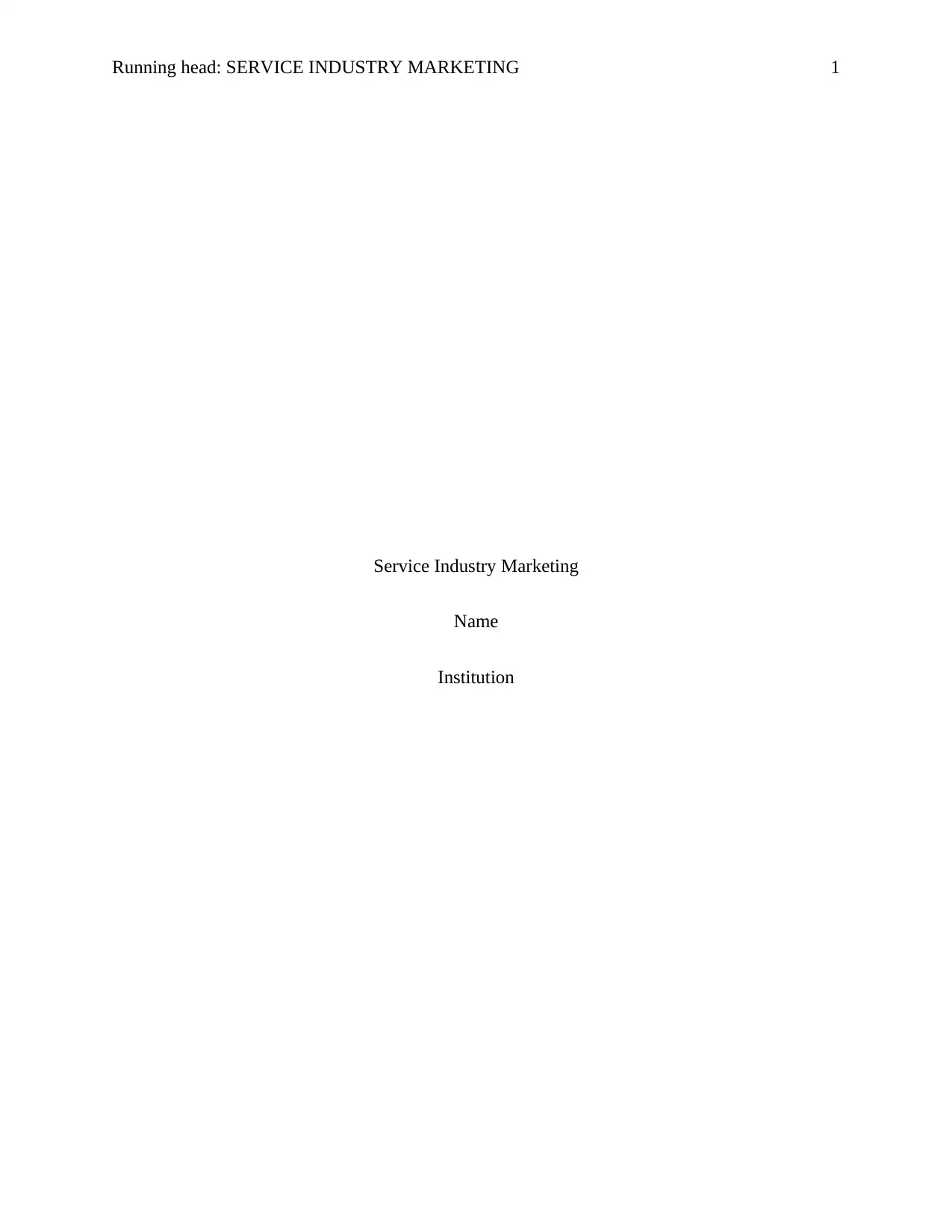
Running head: SERVICE INDUSTRY MARKETING 1
Service Industry Marketing
Name
Institution
Service Industry Marketing
Name
Institution
Paraphrase This Document
Need a fresh take? Get an instant paraphrase of this document with our AI Paraphraser
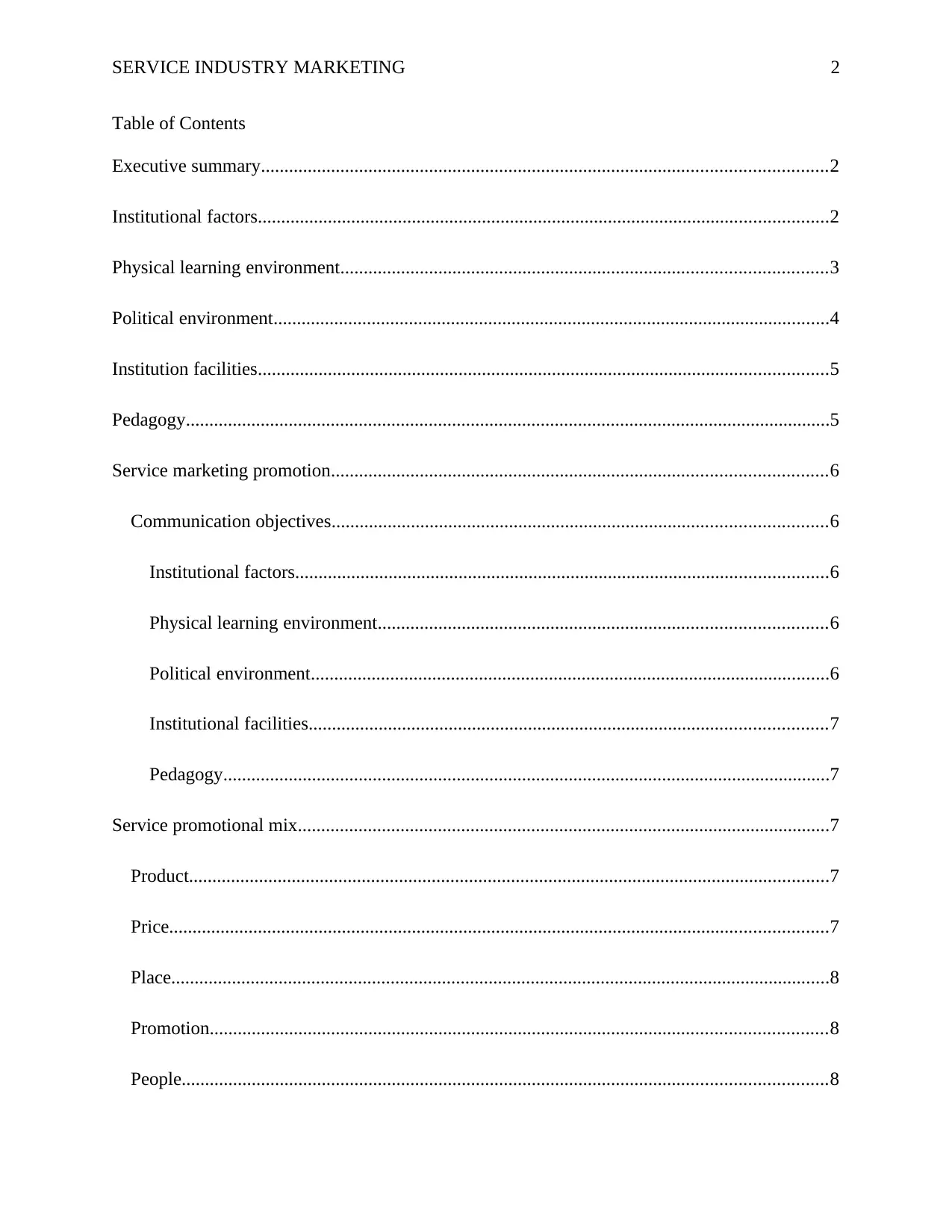
SERVICE INDUSTRY MARKETING 2
Table of Contents
Executive summary.........................................................................................................................2
Institutional factors..........................................................................................................................2
Physical learning environment........................................................................................................3
Political environment.......................................................................................................................4
Institution facilities..........................................................................................................................5
Pedagogy..........................................................................................................................................5
Service marketing promotion..........................................................................................................6
Communication objectives..........................................................................................................6
Institutional factors..................................................................................................................6
Physical learning environment................................................................................................6
Political environment...............................................................................................................6
Institutional facilities...............................................................................................................7
Pedagogy..................................................................................................................................7
Service promotional mix..................................................................................................................7
Product.........................................................................................................................................7
Price.............................................................................................................................................7
Place.............................................................................................................................................8
Promotion....................................................................................................................................8
People..........................................................................................................................................8
Table of Contents
Executive summary.........................................................................................................................2
Institutional factors..........................................................................................................................2
Physical learning environment........................................................................................................3
Political environment.......................................................................................................................4
Institution facilities..........................................................................................................................5
Pedagogy..........................................................................................................................................5
Service marketing promotion..........................................................................................................6
Communication objectives..........................................................................................................6
Institutional factors..................................................................................................................6
Physical learning environment................................................................................................6
Political environment...............................................................................................................6
Institutional facilities...............................................................................................................7
Pedagogy..................................................................................................................................7
Service promotional mix..................................................................................................................7
Product.........................................................................................................................................7
Price.............................................................................................................................................7
Place.............................................................................................................................................8
Promotion....................................................................................................................................8
People..........................................................................................................................................8
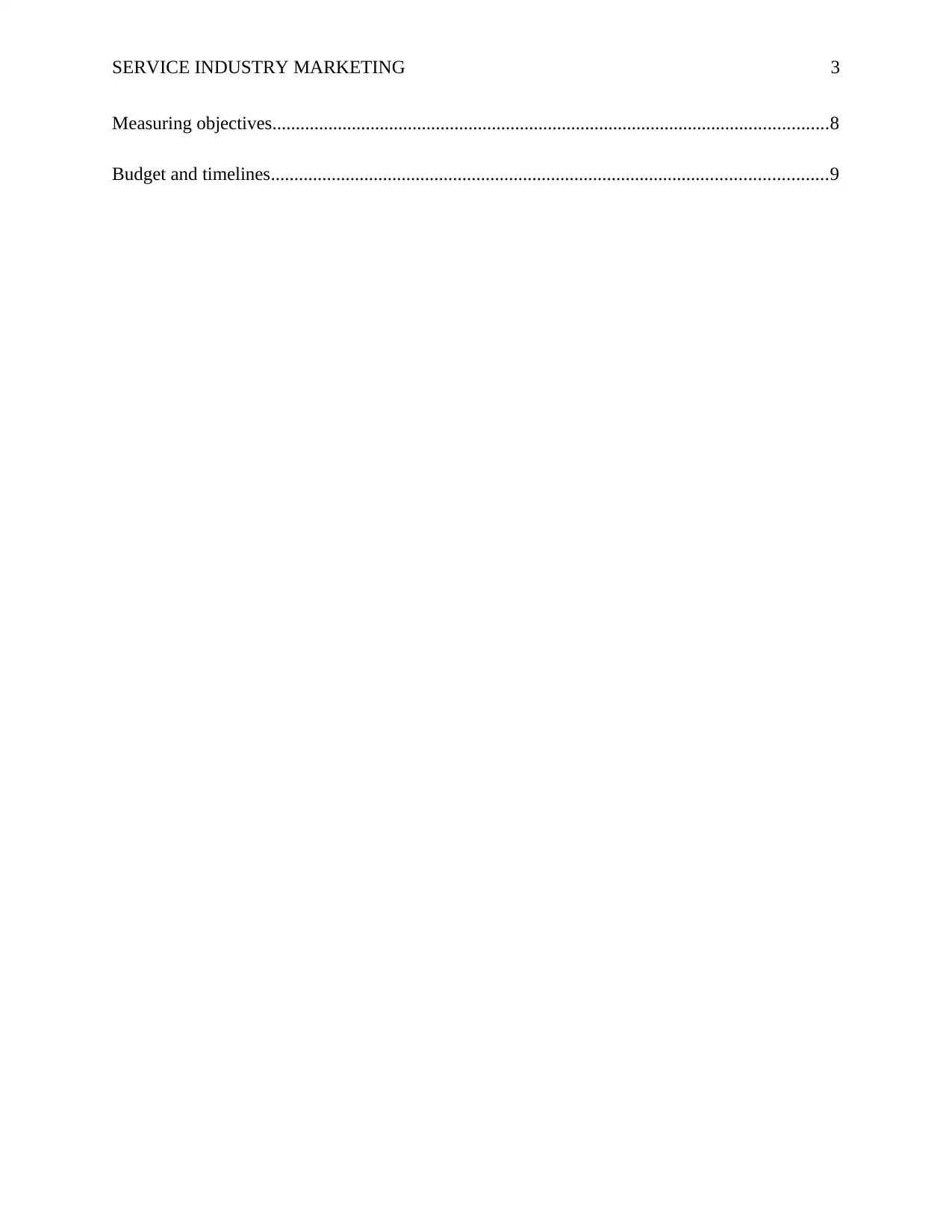
SERVICE INDUSTRY MARKETING 3
Measuring objectives.......................................................................................................................8
Budget and timelines.......................................................................................................................9
Measuring objectives.......................................................................................................................8
Budget and timelines.......................................................................................................................9
⊘ This is a preview!⊘
Do you want full access?
Subscribe today to unlock all pages.

Trusted by 1+ million students worldwide
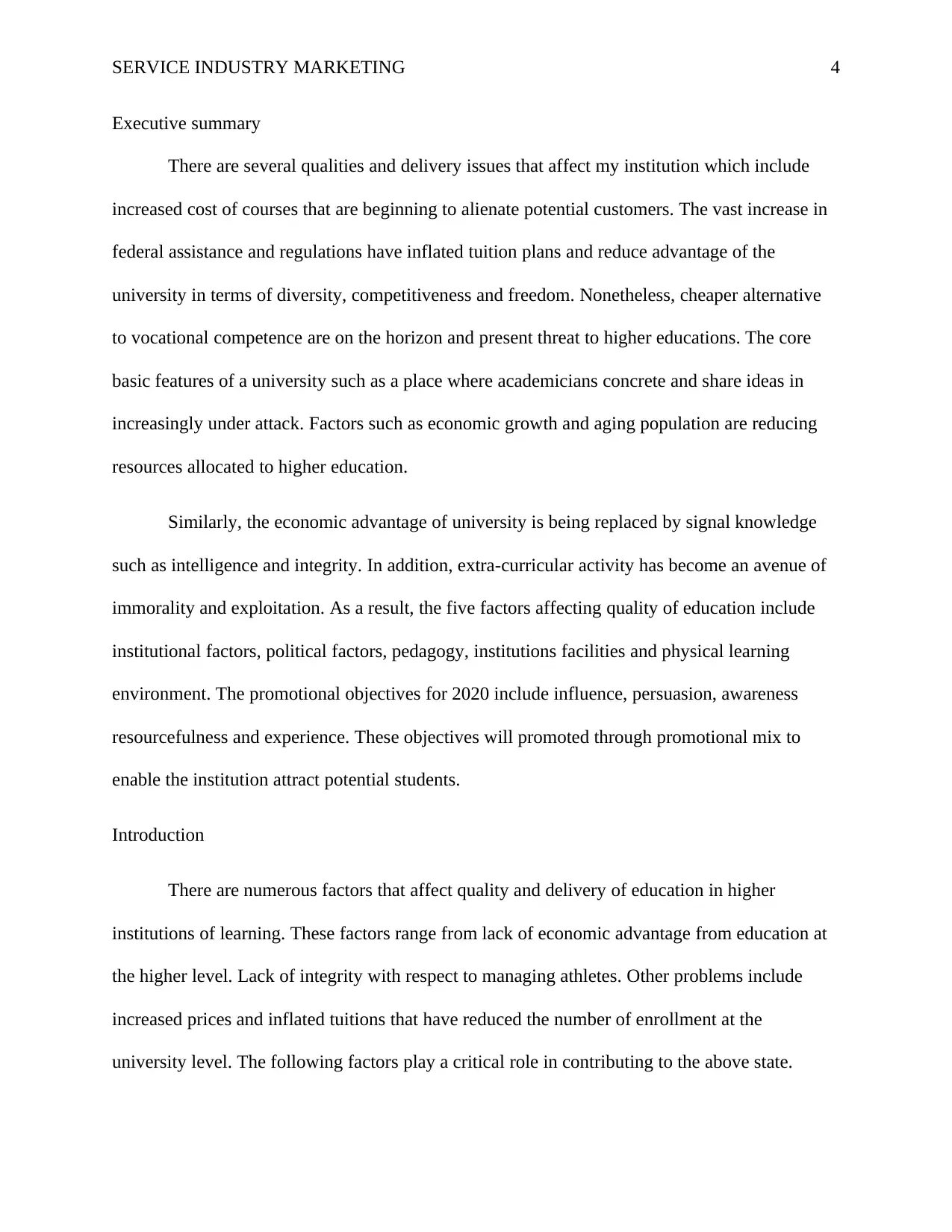
SERVICE INDUSTRY MARKETING 4
Executive summary
There are several qualities and delivery issues that affect my institution which include
increased cost of courses that are beginning to alienate potential customers. The vast increase in
federal assistance and regulations have inflated tuition plans and reduce advantage of the
university in terms of diversity, competitiveness and freedom. Nonetheless, cheaper alternative
to vocational competence are on the horizon and present threat to higher educations. The core
basic features of a university such as a place where academicians concrete and share ideas in
increasingly under attack. Factors such as economic growth and aging population are reducing
resources allocated to higher education.
Similarly, the economic advantage of university is being replaced by signal knowledge
such as intelligence and integrity. In addition, extra-curricular activity has become an avenue of
immorality and exploitation. As a result, the five factors affecting quality of education include
institutional factors, political factors, pedagogy, institutions facilities and physical learning
environment. The promotional objectives for 2020 include influence, persuasion, awareness
resourcefulness and experience. These objectives will promoted through promotional mix to
enable the institution attract potential students.
Introduction
There are numerous factors that affect quality and delivery of education in higher
institutions of learning. These factors range from lack of economic advantage from education at
the higher level. Lack of integrity with respect to managing athletes. Other problems include
increased prices and inflated tuitions that have reduced the number of enrollment at the
university level. The following factors play a critical role in contributing to the above state.
Executive summary
There are several qualities and delivery issues that affect my institution which include
increased cost of courses that are beginning to alienate potential customers. The vast increase in
federal assistance and regulations have inflated tuition plans and reduce advantage of the
university in terms of diversity, competitiveness and freedom. Nonetheless, cheaper alternative
to vocational competence are on the horizon and present threat to higher educations. The core
basic features of a university such as a place where academicians concrete and share ideas in
increasingly under attack. Factors such as economic growth and aging population are reducing
resources allocated to higher education.
Similarly, the economic advantage of university is being replaced by signal knowledge
such as intelligence and integrity. In addition, extra-curricular activity has become an avenue of
immorality and exploitation. As a result, the five factors affecting quality of education include
institutional factors, political factors, pedagogy, institutions facilities and physical learning
environment. The promotional objectives for 2020 include influence, persuasion, awareness
resourcefulness and experience. These objectives will promoted through promotional mix to
enable the institution attract potential students.
Introduction
There are numerous factors that affect quality and delivery of education in higher
institutions of learning. These factors range from lack of economic advantage from education at
the higher level. Lack of integrity with respect to managing athletes. Other problems include
increased prices and inflated tuitions that have reduced the number of enrollment at the
university level. The following factors play a critical role in contributing to the above state.
Paraphrase This Document
Need a fresh take? Get an instant paraphrase of this document with our AI Paraphraser
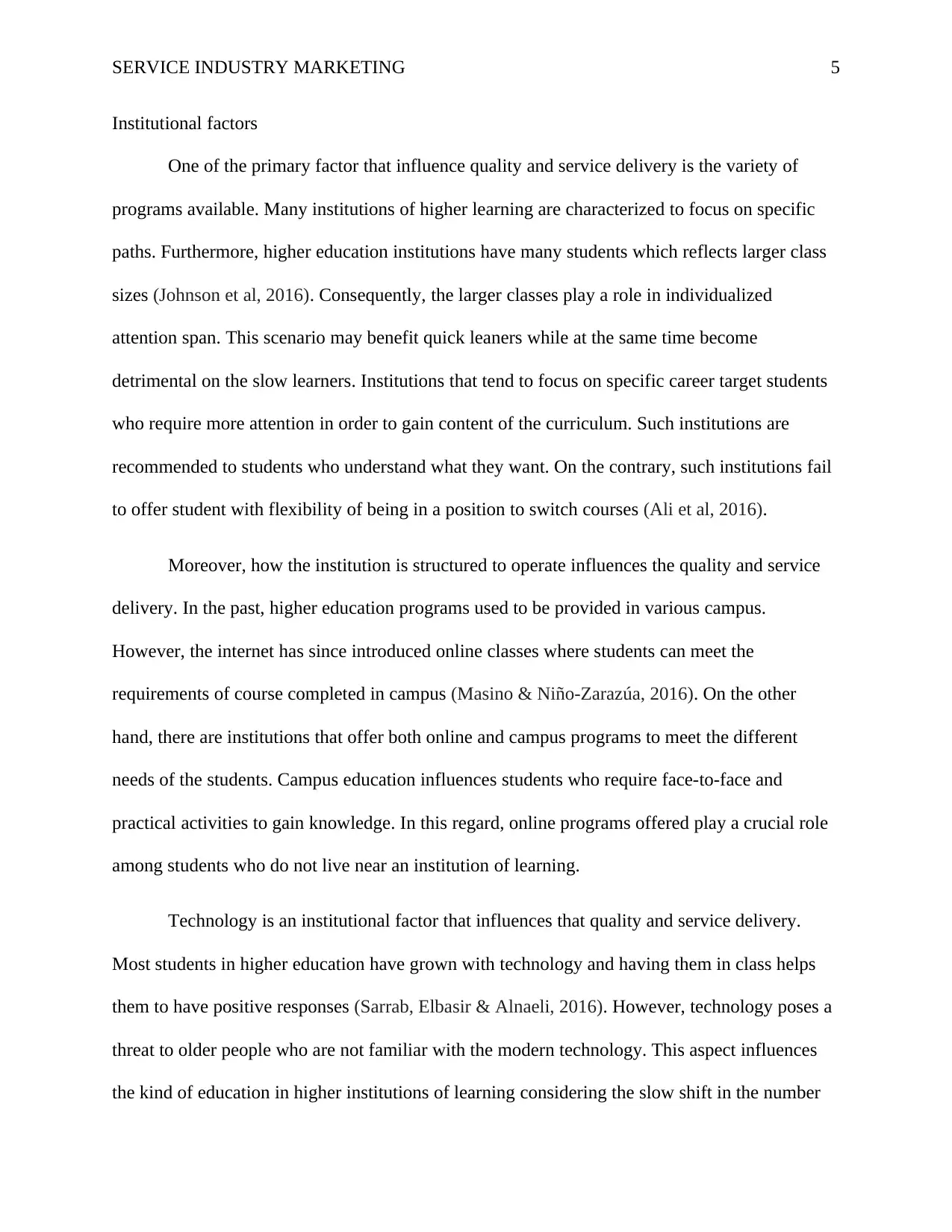
SERVICE INDUSTRY MARKETING 5
Institutional factors
One of the primary factor that influence quality and service delivery is the variety of
programs available. Many institutions of higher learning are characterized to focus on specific
paths. Furthermore, higher education institutions have many students which reflects larger class
sizes (Johnson et al, 2016). Consequently, the larger classes play a role in individualized
attention span. This scenario may benefit quick leaners while at the same time become
detrimental on the slow learners. Institutions that tend to focus on specific career target students
who require more attention in order to gain content of the curriculum. Such institutions are
recommended to students who understand what they want. On the contrary, such institutions fail
to offer student with flexibility of being in a position to switch courses (Ali et al, 2016).
Moreover, how the institution is structured to operate influences the quality and service
delivery. In the past, higher education programs used to be provided in various campus.
However, the internet has since introduced online classes where students can meet the
requirements of course completed in campus (Masino & Niño-Zarazúa, 2016). On the other
hand, there are institutions that offer both online and campus programs to meet the different
needs of the students. Campus education influences students who require face-to-face and
practical activities to gain knowledge. In this regard, online programs offered play a crucial role
among students who do not live near an institution of learning.
Technology is an institutional factor that influences that quality and service delivery.
Most students in higher education have grown with technology and having them in class helps
them to have positive responses (Sarrab, Elbasir & Alnaeli, 2016). However, technology poses a
threat to older people who are not familiar with the modern technology. This aspect influences
the kind of education in higher institutions of learning considering the slow shift in the number
Institutional factors
One of the primary factor that influence quality and service delivery is the variety of
programs available. Many institutions of higher learning are characterized to focus on specific
paths. Furthermore, higher education institutions have many students which reflects larger class
sizes (Johnson et al, 2016). Consequently, the larger classes play a role in individualized
attention span. This scenario may benefit quick leaners while at the same time become
detrimental on the slow learners. Institutions that tend to focus on specific career target students
who require more attention in order to gain content of the curriculum. Such institutions are
recommended to students who understand what they want. On the contrary, such institutions fail
to offer student with flexibility of being in a position to switch courses (Ali et al, 2016).
Moreover, how the institution is structured to operate influences the quality and service
delivery. In the past, higher education programs used to be provided in various campus.
However, the internet has since introduced online classes where students can meet the
requirements of course completed in campus (Masino & Niño-Zarazúa, 2016). On the other
hand, there are institutions that offer both online and campus programs to meet the different
needs of the students. Campus education influences students who require face-to-face and
practical activities to gain knowledge. In this regard, online programs offered play a crucial role
among students who do not live near an institution of learning.
Technology is an institutional factor that influences that quality and service delivery.
Most students in higher education have grown with technology and having them in class helps
them to have positive responses (Sarrab, Elbasir & Alnaeli, 2016). However, technology poses a
threat to older people who are not familiar with the modern technology. This aspect influences
the kind of education in higher institutions of learning considering the slow shift in the number
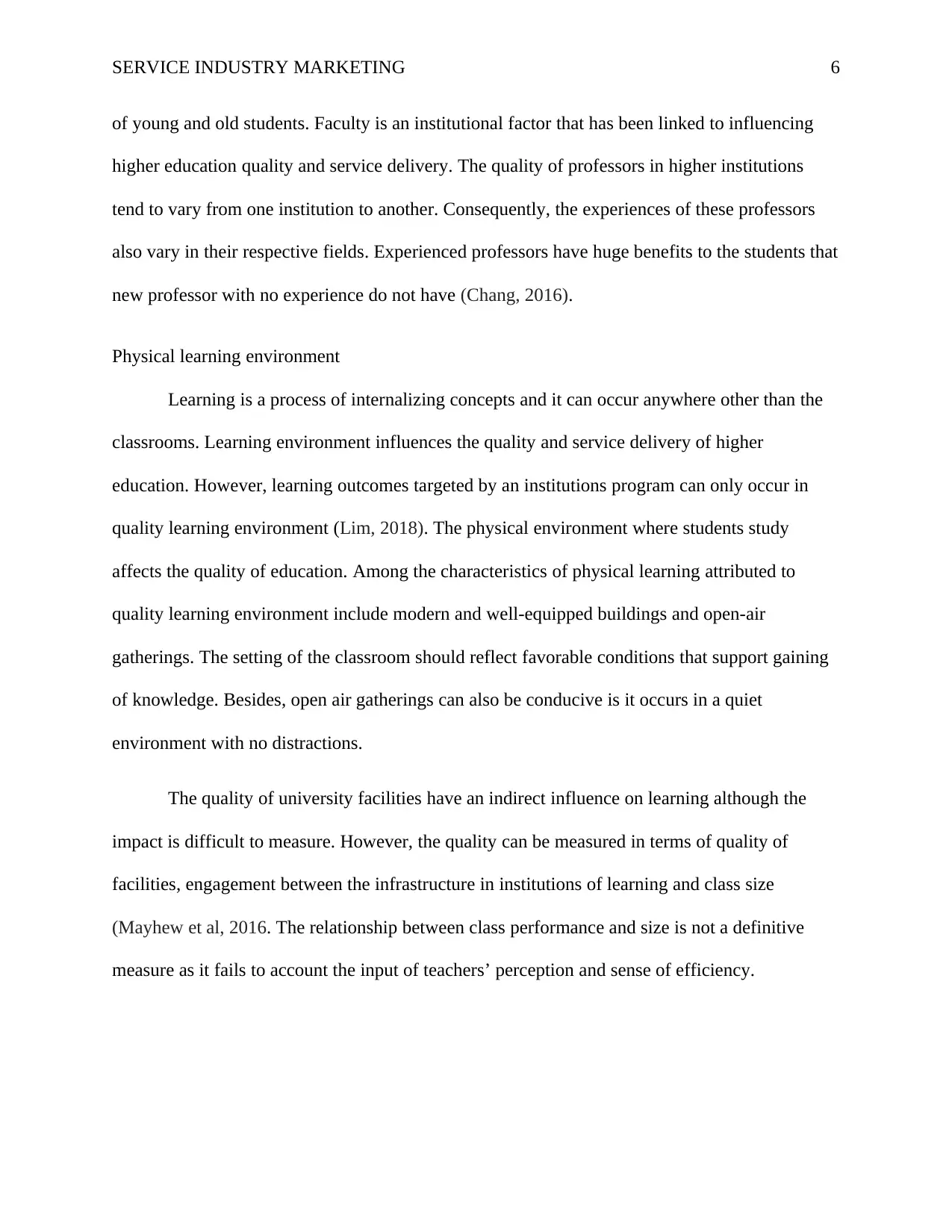
SERVICE INDUSTRY MARKETING 6
of young and old students. Faculty is an institutional factor that has been linked to influencing
higher education quality and service delivery. The quality of professors in higher institutions
tend to vary from one institution to another. Consequently, the experiences of these professors
also vary in their respective fields. Experienced professors have huge benefits to the students that
new professor with no experience do not have (Chang, 2016).
Physical learning environment
Learning is a process of internalizing concepts and it can occur anywhere other than the
classrooms. Learning environment influences the quality and service delivery of higher
education. However, learning outcomes targeted by an institutions program can only occur in
quality learning environment (Lim, 2018). The physical environment where students study
affects the quality of education. Among the characteristics of physical learning attributed to
quality learning environment include modern and well-equipped buildings and open-air
gatherings. The setting of the classroom should reflect favorable conditions that support gaining
of knowledge. Besides, open air gatherings can also be conducive is it occurs in a quiet
environment with no distractions.
The quality of university facilities have an indirect influence on learning although the
impact is difficult to measure. However, the quality can be measured in terms of quality of
facilities, engagement between the infrastructure in institutions of learning and class size
(Mayhew et al, 2016. The relationship between class performance and size is not a definitive
measure as it fails to account the input of teachers’ perception and sense of efficiency.
of young and old students. Faculty is an institutional factor that has been linked to influencing
higher education quality and service delivery. The quality of professors in higher institutions
tend to vary from one institution to another. Consequently, the experiences of these professors
also vary in their respective fields. Experienced professors have huge benefits to the students that
new professor with no experience do not have (Chang, 2016).
Physical learning environment
Learning is a process of internalizing concepts and it can occur anywhere other than the
classrooms. Learning environment influences the quality and service delivery of higher
education. However, learning outcomes targeted by an institutions program can only occur in
quality learning environment (Lim, 2018). The physical environment where students study
affects the quality of education. Among the characteristics of physical learning attributed to
quality learning environment include modern and well-equipped buildings and open-air
gatherings. The setting of the classroom should reflect favorable conditions that support gaining
of knowledge. Besides, open air gatherings can also be conducive is it occurs in a quiet
environment with no distractions.
The quality of university facilities have an indirect influence on learning although the
impact is difficult to measure. However, the quality can be measured in terms of quality of
facilities, engagement between the infrastructure in institutions of learning and class size
(Mayhew et al, 2016. The relationship between class performance and size is not a definitive
measure as it fails to account the input of teachers’ perception and sense of efficiency.
⊘ This is a preview!⊘
Do you want full access?
Subscribe today to unlock all pages.

Trusted by 1+ million students worldwide
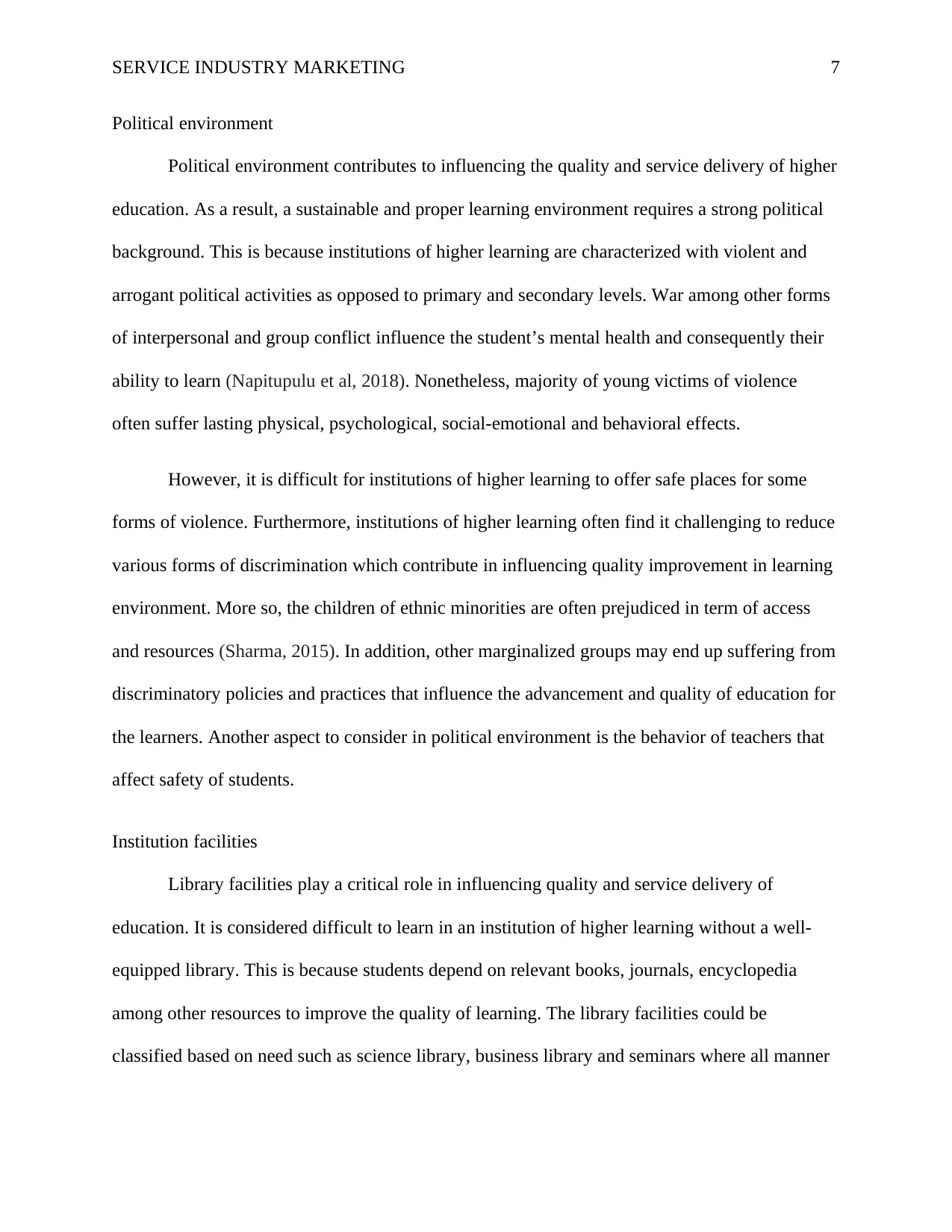
SERVICE INDUSTRY MARKETING 7
Political environment
Political environment contributes to influencing the quality and service delivery of higher
education. As a result, a sustainable and proper learning environment requires a strong political
background. This is because institutions of higher learning are characterized with violent and
arrogant political activities as opposed to primary and secondary levels. War among other forms
of interpersonal and group conflict influence the student’s mental health and consequently their
ability to learn (Napitupulu et al, 2018). Nonetheless, majority of young victims of violence
often suffer lasting physical, psychological, social-emotional and behavioral effects.
However, it is difficult for institutions of higher learning to offer safe places for some
forms of violence. Furthermore, institutions of higher learning often find it challenging to reduce
various forms of discrimination which contribute in influencing quality improvement in learning
environment. More so, the children of ethnic minorities are often prejudiced in term of access
and resources (Sharma, 2015). In addition, other marginalized groups may end up suffering from
discriminatory policies and practices that influence the advancement and quality of education for
the learners. Another aspect to consider in political environment is the behavior of teachers that
affect safety of students.
Institution facilities
Library facilities play a critical role in influencing quality and service delivery of
education. It is considered difficult to learn in an institution of higher learning without a well-
equipped library. This is because students depend on relevant books, journals, encyclopedia
among other resources to improve the quality of learning. The library facilities could be
classified based on need such as science library, business library and seminars where all manner
Political environment
Political environment contributes to influencing the quality and service delivery of higher
education. As a result, a sustainable and proper learning environment requires a strong political
background. This is because institutions of higher learning are characterized with violent and
arrogant political activities as opposed to primary and secondary levels. War among other forms
of interpersonal and group conflict influence the student’s mental health and consequently their
ability to learn (Napitupulu et al, 2018). Nonetheless, majority of young victims of violence
often suffer lasting physical, psychological, social-emotional and behavioral effects.
However, it is difficult for institutions of higher learning to offer safe places for some
forms of violence. Furthermore, institutions of higher learning often find it challenging to reduce
various forms of discrimination which contribute in influencing quality improvement in learning
environment. More so, the children of ethnic minorities are often prejudiced in term of access
and resources (Sharma, 2015). In addition, other marginalized groups may end up suffering from
discriminatory policies and practices that influence the advancement and quality of education for
the learners. Another aspect to consider in political environment is the behavior of teachers that
affect safety of students.
Institution facilities
Library facilities play a critical role in influencing quality and service delivery of
education. It is considered difficult to learn in an institution of higher learning without a well-
equipped library. This is because students depend on relevant books, journals, encyclopedia
among other resources to improve the quality of learning. The library facilities could be
classified based on need such as science library, business library and seminars where all manner
Paraphrase This Document
Need a fresh take? Get an instant paraphrase of this document with our AI Paraphraser
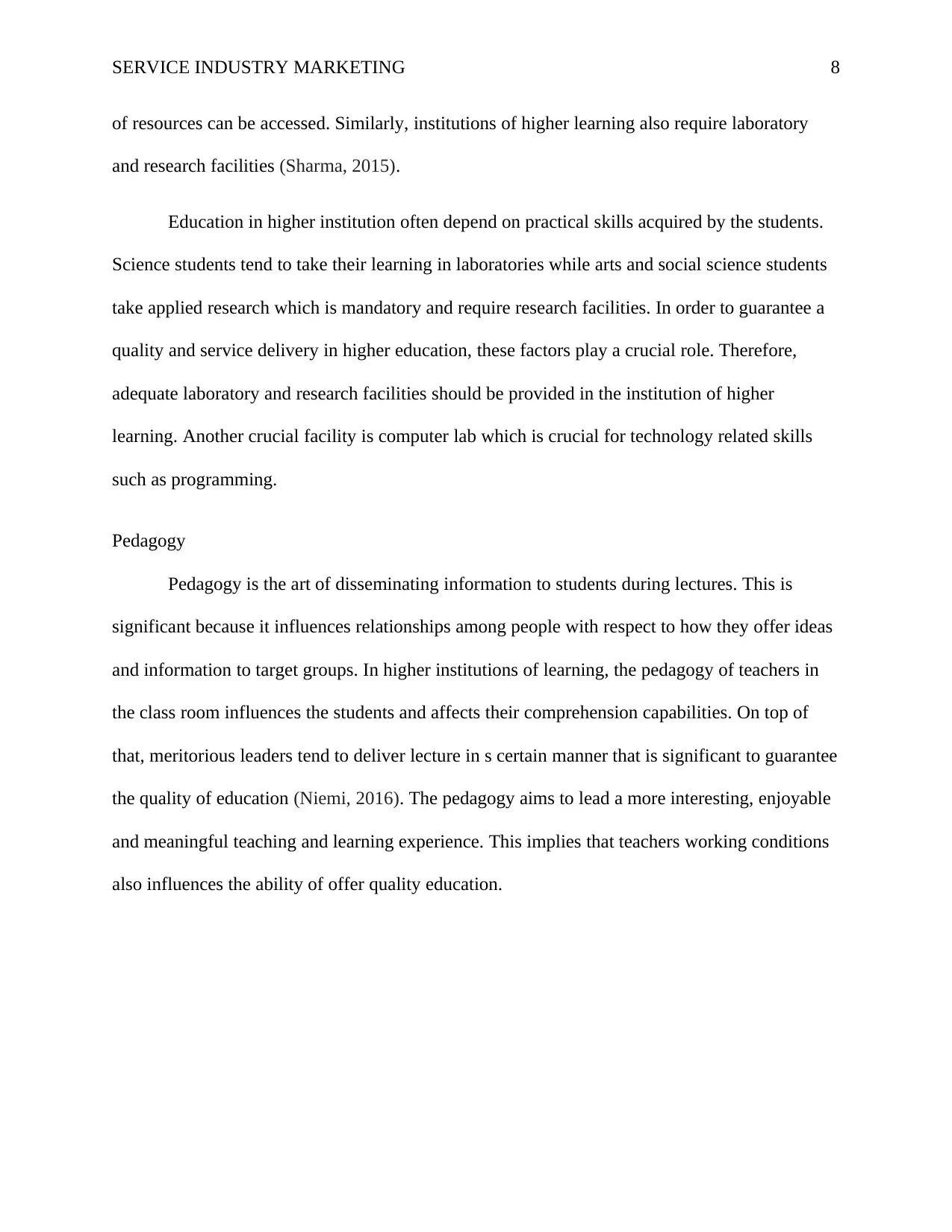
SERVICE INDUSTRY MARKETING 8
of resources can be accessed. Similarly, institutions of higher learning also require laboratory
and research facilities (Sharma, 2015).
Education in higher institution often depend on practical skills acquired by the students.
Science students tend to take their learning in laboratories while arts and social science students
take applied research which is mandatory and require research facilities. In order to guarantee a
quality and service delivery in higher education, these factors play a crucial role. Therefore,
adequate laboratory and research facilities should be provided in the institution of higher
learning. Another crucial facility is computer lab which is crucial for technology related skills
such as programming.
Pedagogy
Pedagogy is the art of disseminating information to students during lectures. This is
significant because it influences relationships among people with respect to how they offer ideas
and information to target groups. In higher institutions of learning, the pedagogy of teachers in
the class room influences the students and affects their comprehension capabilities. On top of
that, meritorious leaders tend to deliver lecture in s certain manner that is significant to guarantee
the quality of education (Niemi, 2016). The pedagogy aims to lead a more interesting, enjoyable
and meaningful teaching and learning experience. This implies that teachers working conditions
also influences the ability of offer quality education.
of resources can be accessed. Similarly, institutions of higher learning also require laboratory
and research facilities (Sharma, 2015).
Education in higher institution often depend on practical skills acquired by the students.
Science students tend to take their learning in laboratories while arts and social science students
take applied research which is mandatory and require research facilities. In order to guarantee a
quality and service delivery in higher education, these factors play a crucial role. Therefore,
adequate laboratory and research facilities should be provided in the institution of higher
learning. Another crucial facility is computer lab which is crucial for technology related skills
such as programming.
Pedagogy
Pedagogy is the art of disseminating information to students during lectures. This is
significant because it influences relationships among people with respect to how they offer ideas
and information to target groups. In higher institutions of learning, the pedagogy of teachers in
the class room influences the students and affects their comprehension capabilities. On top of
that, meritorious leaders tend to deliver lecture in s certain manner that is significant to guarantee
the quality of education (Niemi, 2016). The pedagogy aims to lead a more interesting, enjoyable
and meaningful teaching and learning experience. This implies that teachers working conditions
also influences the ability of offer quality education.
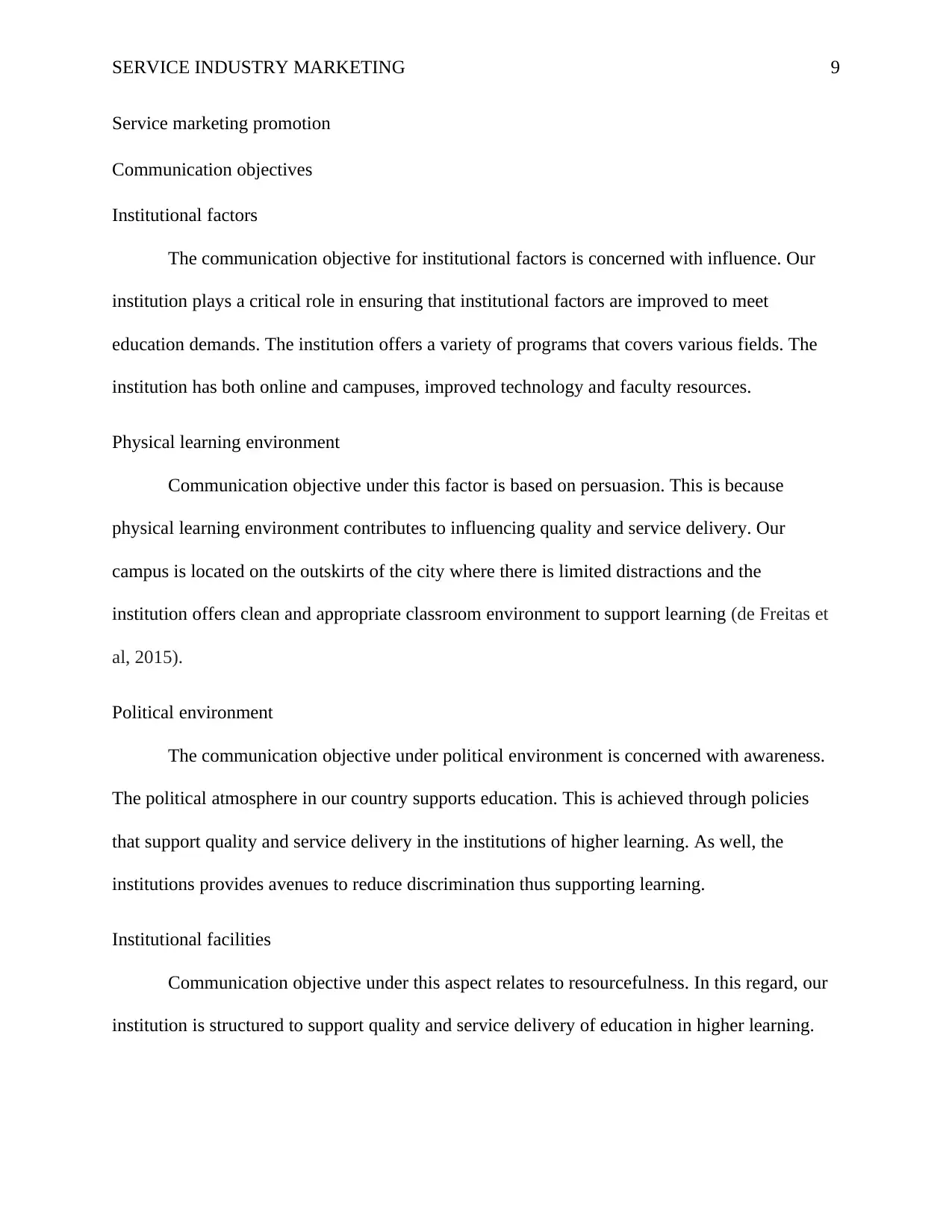
SERVICE INDUSTRY MARKETING 9
Service marketing promotion
Communication objectives
Institutional factors
The communication objective for institutional factors is concerned with influence. Our
institution plays a critical role in ensuring that institutional factors are improved to meet
education demands. The institution offers a variety of programs that covers various fields. The
institution has both online and campuses, improved technology and faculty resources.
Physical learning environment
Communication objective under this factor is based on persuasion. This is because
physical learning environment contributes to influencing quality and service delivery. Our
campus is located on the outskirts of the city where there is limited distractions and the
institution offers clean and appropriate classroom environment to support learning (de Freitas et
al, 2015).
Political environment
The communication objective under political environment is concerned with awareness.
The political atmosphere in our country supports education. This is achieved through policies
that support quality and service delivery in the institutions of higher learning. As well, the
institutions provides avenues to reduce discrimination thus supporting learning.
Institutional facilities
Communication objective under this aspect relates to resourcefulness. In this regard, our
institution is structured to support quality and service delivery of education in higher learning.
Service marketing promotion
Communication objectives
Institutional factors
The communication objective for institutional factors is concerned with influence. Our
institution plays a critical role in ensuring that institutional factors are improved to meet
education demands. The institution offers a variety of programs that covers various fields. The
institution has both online and campuses, improved technology and faculty resources.
Physical learning environment
Communication objective under this factor is based on persuasion. This is because
physical learning environment contributes to influencing quality and service delivery. Our
campus is located on the outskirts of the city where there is limited distractions and the
institution offers clean and appropriate classroom environment to support learning (de Freitas et
al, 2015).
Political environment
The communication objective under political environment is concerned with awareness.
The political atmosphere in our country supports education. This is achieved through policies
that support quality and service delivery in the institutions of higher learning. As well, the
institutions provides avenues to reduce discrimination thus supporting learning.
Institutional facilities
Communication objective under this aspect relates to resourcefulness. In this regard, our
institution is structured to support quality and service delivery of education in higher learning.
⊘ This is a preview!⊘
Do you want full access?
Subscribe today to unlock all pages.

Trusted by 1+ million students worldwide
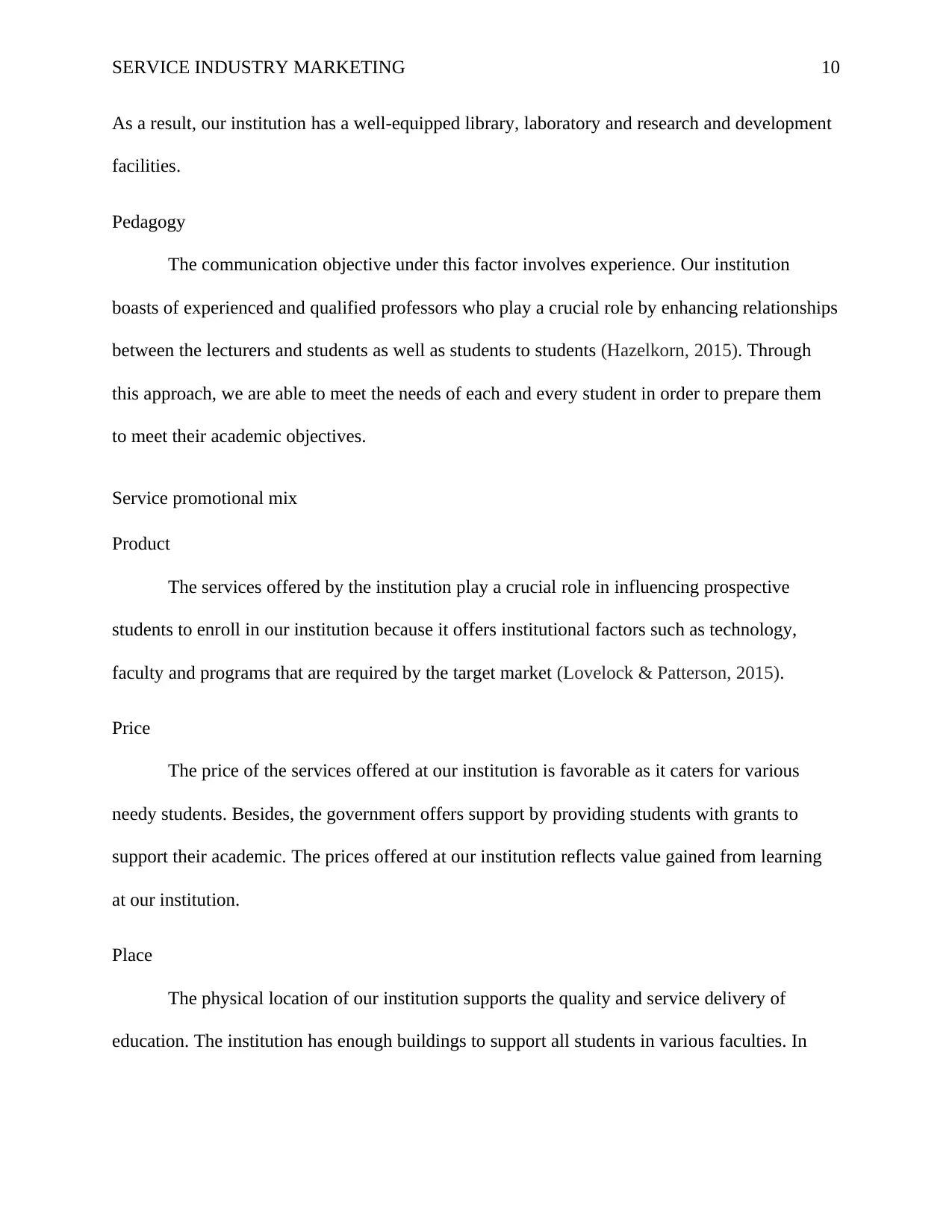
SERVICE INDUSTRY MARKETING 10
As a result, our institution has a well-equipped library, laboratory and research and development
facilities.
Pedagogy
The communication objective under this factor involves experience. Our institution
boasts of experienced and qualified professors who play a crucial role by enhancing relationships
between the lecturers and students as well as students to students (Hazelkorn, 2015). Through
this approach, we are able to meet the needs of each and every student in order to prepare them
to meet their academic objectives.
Service promotional mix
Product
The services offered by the institution play a crucial role in influencing prospective
students to enroll in our institution because it offers institutional factors such as technology,
faculty and programs that are required by the target market (Lovelock & Patterson, 2015).
Price
The price of the services offered at our institution is favorable as it caters for various
needy students. Besides, the government offers support by providing students with grants to
support their academic. The prices offered at our institution reflects value gained from learning
at our institution.
Place
The physical location of our institution supports the quality and service delivery of
education. The institution has enough buildings to support all students in various faculties. In
As a result, our institution has a well-equipped library, laboratory and research and development
facilities.
Pedagogy
The communication objective under this factor involves experience. Our institution
boasts of experienced and qualified professors who play a crucial role by enhancing relationships
between the lecturers and students as well as students to students (Hazelkorn, 2015). Through
this approach, we are able to meet the needs of each and every student in order to prepare them
to meet their academic objectives.
Service promotional mix
Product
The services offered by the institution play a crucial role in influencing prospective
students to enroll in our institution because it offers institutional factors such as technology,
faculty and programs that are required by the target market (Lovelock & Patterson, 2015).
Price
The price of the services offered at our institution is favorable as it caters for various
needy students. Besides, the government offers support by providing students with grants to
support their academic. The prices offered at our institution reflects value gained from learning
at our institution.
Place
The physical location of our institution supports the quality and service delivery of
education. The institution has enough buildings to support all students in various faculties. In
Paraphrase This Document
Need a fresh take? Get an instant paraphrase of this document with our AI Paraphraser
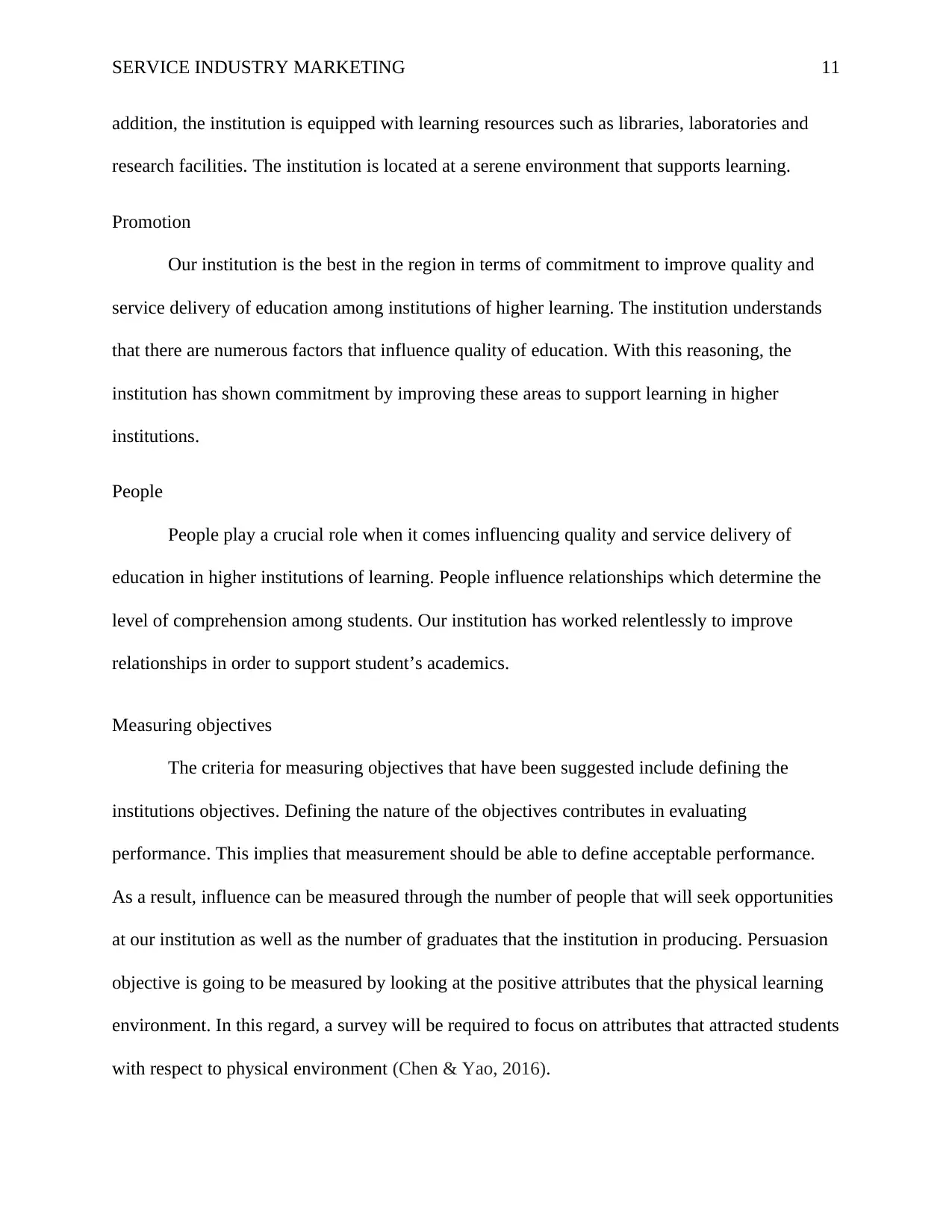
SERVICE INDUSTRY MARKETING 11
addition, the institution is equipped with learning resources such as libraries, laboratories and
research facilities. The institution is located at a serene environment that supports learning.
Promotion
Our institution is the best in the region in terms of commitment to improve quality and
service delivery of education among institutions of higher learning. The institution understands
that there are numerous factors that influence quality of education. With this reasoning, the
institution has shown commitment by improving these areas to support learning in higher
institutions.
People
People play a crucial role when it comes influencing quality and service delivery of
education in higher institutions of learning. People influence relationships which determine the
level of comprehension among students. Our institution has worked relentlessly to improve
relationships in order to support student’s academics.
Measuring objectives
The criteria for measuring objectives that have been suggested include defining the
institutions objectives. Defining the nature of the objectives contributes in evaluating
performance. This implies that measurement should be able to define acceptable performance.
As a result, influence can be measured through the number of people that will seek opportunities
at our institution as well as the number of graduates that the institution in producing. Persuasion
objective is going to be measured by looking at the positive attributes that the physical learning
environment. In this regard, a survey will be required to focus on attributes that attracted students
with respect to physical environment (Chen & Yao, 2016).
addition, the institution is equipped with learning resources such as libraries, laboratories and
research facilities. The institution is located at a serene environment that supports learning.
Promotion
Our institution is the best in the region in terms of commitment to improve quality and
service delivery of education among institutions of higher learning. The institution understands
that there are numerous factors that influence quality of education. With this reasoning, the
institution has shown commitment by improving these areas to support learning in higher
institutions.
People
People play a crucial role when it comes influencing quality and service delivery of
education in higher institutions of learning. People influence relationships which determine the
level of comprehension among students. Our institution has worked relentlessly to improve
relationships in order to support student’s academics.
Measuring objectives
The criteria for measuring objectives that have been suggested include defining the
institutions objectives. Defining the nature of the objectives contributes in evaluating
performance. This implies that measurement should be able to define acceptable performance.
As a result, influence can be measured through the number of people that will seek opportunities
at our institution as well as the number of graduates that the institution in producing. Persuasion
objective is going to be measured by looking at the positive attributes that the physical learning
environment. In this regard, a survey will be required to focus on attributes that attracted students
with respect to physical environment (Chen & Yao, 2016).
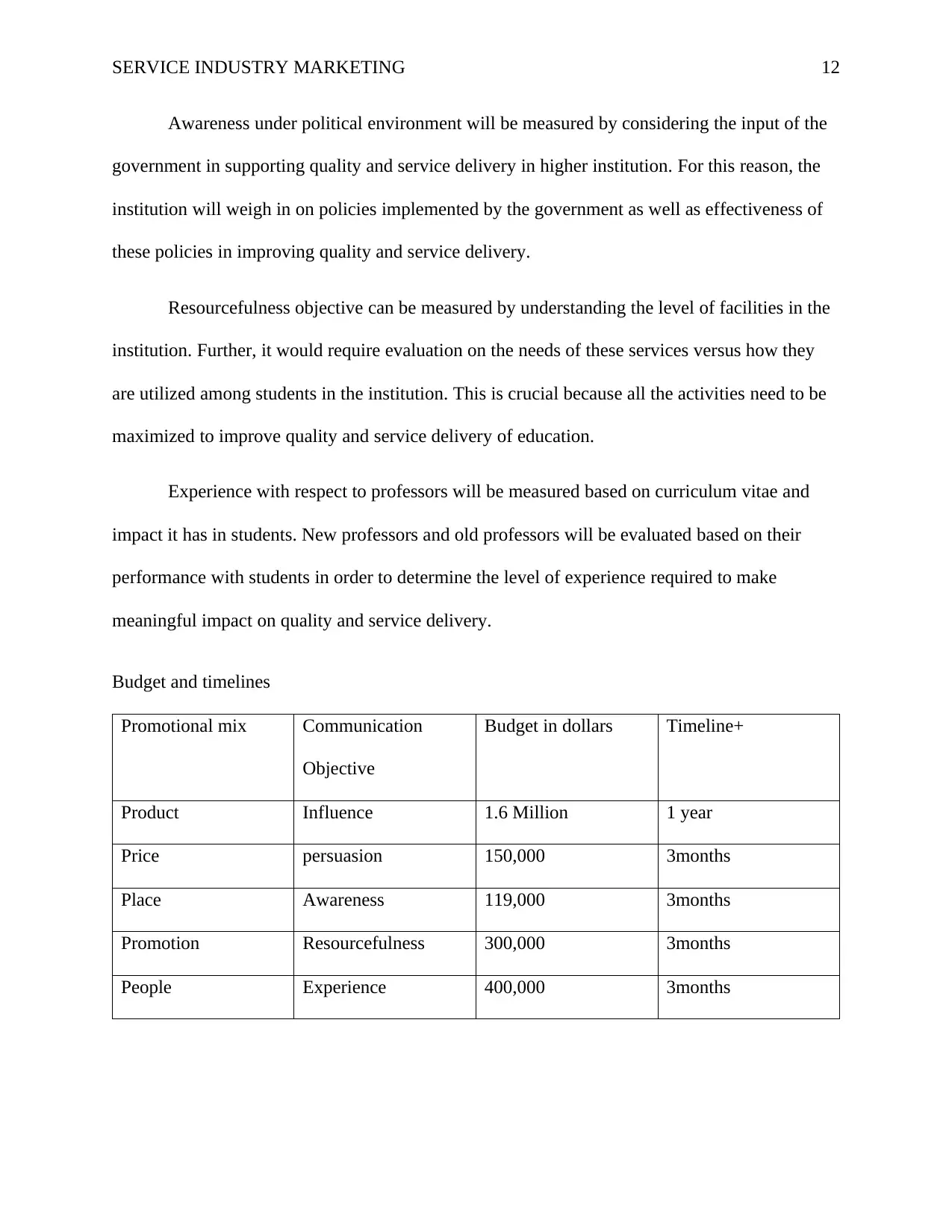
SERVICE INDUSTRY MARKETING 12
Awareness under political environment will be measured by considering the input of the
government in supporting quality and service delivery in higher institution. For this reason, the
institution will weigh in on policies implemented by the government as well as effectiveness of
these policies in improving quality and service delivery.
Resourcefulness objective can be measured by understanding the level of facilities in the
institution. Further, it would require evaluation on the needs of these services versus how they
are utilized among students in the institution. This is crucial because all the activities need to be
maximized to improve quality and service delivery of education.
Experience with respect to professors will be measured based on curriculum vitae and
impact it has in students. New professors and old professors will be evaluated based on their
performance with students in order to determine the level of experience required to make
meaningful impact on quality and service delivery.
Budget and timelines
Promotional mix Communication
Objective
Budget in dollars Timeline+
Product Influence 1.6 Million 1 year
Price persuasion 150,000 3months
Place Awareness 119,000 3months
Promotion Resourcefulness 300,000 3months
People Experience 400,000 3months
Awareness under political environment will be measured by considering the input of the
government in supporting quality and service delivery in higher institution. For this reason, the
institution will weigh in on policies implemented by the government as well as effectiveness of
these policies in improving quality and service delivery.
Resourcefulness objective can be measured by understanding the level of facilities in the
institution. Further, it would require evaluation on the needs of these services versus how they
are utilized among students in the institution. This is crucial because all the activities need to be
maximized to improve quality and service delivery of education.
Experience with respect to professors will be measured based on curriculum vitae and
impact it has in students. New professors and old professors will be evaluated based on their
performance with students in order to determine the level of experience required to make
meaningful impact on quality and service delivery.
Budget and timelines
Promotional mix Communication
Objective
Budget in dollars Timeline+
Product Influence 1.6 Million 1 year
Price persuasion 150,000 3months
Place Awareness 119,000 3months
Promotion Resourcefulness 300,000 3months
People Experience 400,000 3months
⊘ This is a preview!⊘
Do you want full access?
Subscribe today to unlock all pages.

Trusted by 1+ million students worldwide
1 out of 15
Related Documents
Your All-in-One AI-Powered Toolkit for Academic Success.
+13062052269
info@desklib.com
Available 24*7 on WhatsApp / Email
![[object Object]](/_next/static/media/star-bottom.7253800d.svg)
Unlock your academic potential
Copyright © 2020–2025 A2Z Services. All Rights Reserved. Developed and managed by ZUCOL.





